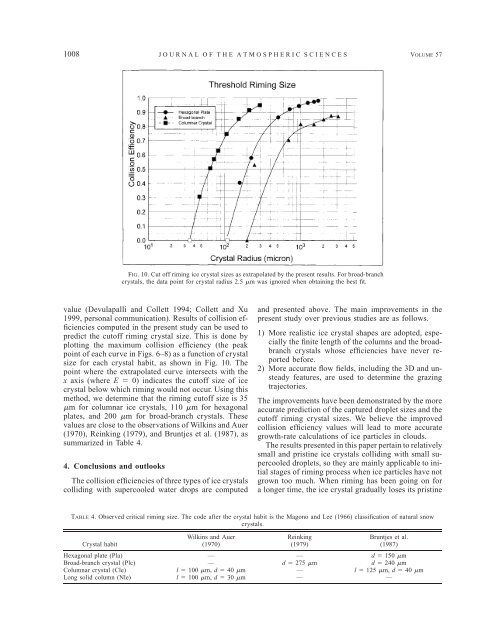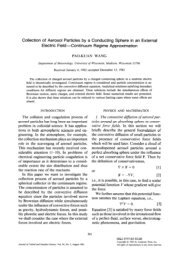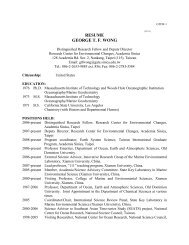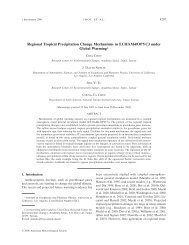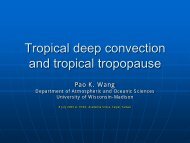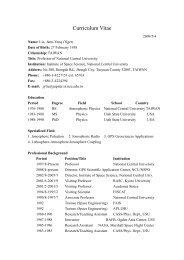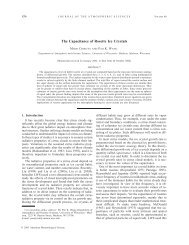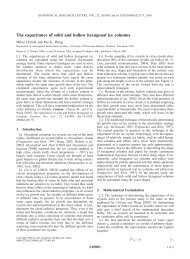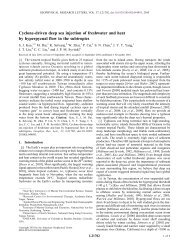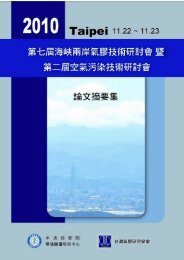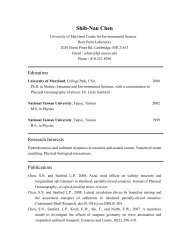1008 JOURNAL OF THE ATMOSPHERIC SCIENCESVOLUME 57FIG. 10. Cut <strong>of</strong>f riming ice crystal sizes as extrapol<strong>at</strong>ed by the present results. For broad-branchcrystals, the d<strong>at</strong>a point for crystal radius 2.5 m was ignored when obtaining the best fit.value (Devulapalli and Collett 1994; Collett and Xu1999, personal communic<strong>at</strong>ion). Results <strong>of</strong> collision efficienciescomputed in the present study can be used topredict the cut<strong>of</strong>f riming crystal size. This is done byplotting the maximum collision efficiency (the peakpoint <strong>of</strong> each curve in Figs. 6–8) as a function <strong>of</strong> crystalsize for each crystal habit, as shown in Fig. 10. Thepoint where the extrapol<strong>at</strong>ed curve intersects with thex axis (where E 0) indic<strong>at</strong>es the cut<strong>of</strong>f size <strong>of</strong> icecrystal below which riming would not occur. Using thismethod, we determine th<strong>at</strong> the riming cut<strong>of</strong>f size is 35m for columnar ice crystals, 110 m for hexagonalpl<strong>at</strong>es, and 200 m for broad-branch crystals. Thesevalues are close to the observ<strong>at</strong>ions <strong>of</strong> Wilkins and Auer(1970), Reinking (1979), and Bruntjes et al. (1987), assummarized in Table 4.4. Conclusions and outlooksThe collision efficiencies <strong>of</strong> three types <strong>of</strong> ice crystalscolliding with supercooled w<strong>at</strong>er drops are computedand presented above. The main improvements in thepresent study over previous studies are as follows.1) More realistic ice crystal shapes are adopted, especiallythe finite length <strong>of</strong> the columns and the broadbranchcrystals whose efficiencies have never reportedbefore.2) More accur<strong>at</strong>e flow fields, including the 3D and unsteadyfe<strong>at</strong>ures, are used to determine the grazingtrajectories.The improvements have been demonstr<strong>at</strong>ed by the moreaccur<strong>at</strong>e prediction <strong>of</strong> the captured droplet sizes and thecut<strong>of</strong>f riming crystal sizes. We believe the improvedcollision efficiency values will lead to more accur<strong>at</strong>egrowth-r<strong>at</strong>e calcul<strong>at</strong>ions <strong>of</strong> ice particles in clouds.The results presented in this paper pertain to rel<strong>at</strong>ivelysmall and pristine ice crystals colliding with small supercooleddroplets, so they are mainly applicable to initialstages <strong>of</strong> riming process when ice particles have notgrown too much. When riming has been going on fora longer time, the ice crystal gradually loses its pristineTABLE 4. Observed critical riming size. The code after the crystal habit is the Magono and Lee (1966) classific<strong>at</strong>ion <strong>of</strong> n<strong>at</strong>ural snowcrystals.Crystal habitWilkins and Auer(1970)Reinking(1979)Bruntjes et al.(1987)Hexagonal pl<strong>at</strong>e (Pla)Broad-branch crystal (Plc)Columnar crystal (Cle)Long solid column (Nle)——l 100 m, d 40 ml 100 m, d 30 m—d 275 m——d 150 md 240 ml 125 m, d 40 m—
15 APRIL 2000 WANG AND JI1009shape. However, as long as the basic shape <strong>of</strong> the icecrystal in question is still discernable, we believe thepresent results are still useful for estim<strong>at</strong>ing the rimingefficiency as the flow fields would not differ too much.As riming goes further, eventually the original shape <strong>of</strong>the ice crystal becomes unrecognizable. The pristine iceassumption no longer applies <strong>at</strong> this stage.As indic<strong>at</strong>ed before, the coalescence <strong>of</strong> the supercooleddrop with the ice surface is assumed to be 100%,so th<strong>at</strong> the case where droplets may bounce <strong>of</strong>f fromthe ice surface is not considered. It is a much morecomplic<strong>at</strong>ed task to determine theoretically the rimingr<strong>at</strong>es <strong>of</strong> larger ice particles such as graupel and hail,where particles are rel<strong>at</strong>ively large and may fall in azigzag <strong>at</strong>titude.Acknowledgments. This work is partially supportedby NSF Grants ATM-9314465, ATM-9633424, ATM-9714158, and ATM-9907761 to the University <strong>of</strong> Wisconsin—Madison.PKW would like to thank Alexandervon Humboldt, Found<strong>at</strong>ion <strong>of</strong> Germany, for the SeniorResearch Humboldt Award he received, and JohnsonWax Company <strong>of</strong> Racine, Wisconsin, for a distinguishedfellowship to his research group th<strong>at</strong> also contributedto this work.REFERENCESBruntjes, R. T., A. J. Heymsfield, and T. W. Krauss, 1987: An examin<strong>at</strong>ion<strong>of</strong> double-pl<strong>at</strong>e ice crystals and the initi<strong>at</strong>ion <strong>of</strong> precipit<strong>at</strong>ionin continental cumulus clouds. J. Atmos. Sci., 44,1331–1349.Cotton, W. R., and R. A. Anthes, 1989: Storm and Cloud Dynamics.Academic Press, 880 pp.D’Enrico, R. E., and A. H. Auer, 1978: An observ<strong>at</strong>ional study <strong>of</strong>the accretional properties <strong>of</strong> ice crystals <strong>of</strong> simple geometricshapes. Preprints, Conf. on Cloud Physics and Atmospheric Electricity,Issaquah, WA, Amer. Meteor. Soc., 114–121.Devulapalli, S. S. N., and J. L. Collett Jr., 1994: The influence <strong>of</strong>riming and frontal dynamics on winter precipit<strong>at</strong>ion chemistryin level terrain. Atmos. Res., 32, 203–213.Harimaya, T., 1975: The timing properties <strong>of</strong> snow crystals. J. Meteor.Soc. Japan., 53, 384–392.Ji, W., and P. K. Wang, 1989: Numerical simul<strong>at</strong>ion <strong>of</strong> three-dimensionalunsteady viscous flow past hexagonal ice crystals in theair—Preliminary results. Atmos. Res., 25, 539–557., and , 1991: Numerical simul<strong>at</strong>ion <strong>of</strong> three-dimensionalunsteady viscous flow past finite cylinders in an unbounded fluid<strong>at</strong> low intermedi<strong>at</strong>e <strong>Reynolds</strong> numbers. Theor. Comput. FluidDyn., 3, 43–59., and , 1999: Ventil<strong>at</strong>ion coefficients for falling ice crystalsin the <strong>at</strong>mosphere <strong>at</strong> low–intermedi<strong>at</strong>e <strong>Reynolds</strong> numbers. J.Atmos. Sci., 56, 829–836.Johnson, D. E., P. K. Wang, and J. M. Straka, 1993: Numerical simul<strong>at</strong>ion<strong>of</strong> the 2 August 1981 CCOPE supercell storm with andwithout ice microphysics. J. Appl. Meteor., 32, 745–759., , and , 1994: A study <strong>of</strong> microphysical processes inthe 2 August 1981 CCOPE supercell storm. Atmos. Res., 33, 93–123.Kajikawa, M., 1974: On the collection efficiency <strong>of</strong> snow crystalsfor cloud droplets. J. Metetor. Soc. Japan, 52, 328–336.Kikuchi, K., and H. Uyeda, 1979: Cloud droplets and rain dropscollected and frozen on n<strong>at</strong>ural snow crystals. J. Meteor. Soc.Japan, 57, 273–281.Lin, H.-M., and P. K. Wang, 1997: A numerical study <strong>of</strong> microphysicalprocesses in the 21 June 1991 northern Taiwan mesoscale precipit<strong>at</strong>ionsystem. Terr. Atmos. Oceanic Sci., 8, 385–404.Martin, J. J., P. K. Wang, H. R. Pruppacher, and R. L. Pitter, 1981:A numerical study <strong>of</strong> the effect <strong>of</strong> electric charges on the efficiencywith which planar ice crystals collect supercooled w<strong>at</strong>erdrops. J. Atmos. Sci., 38, 2462–2469.Miller, N. L., and P. K. Wang, 1989: A theoretical determin<strong>at</strong>ion <strong>of</strong>the efficiency with which aerosol particles are collected by fallingcolumnar ice crystals. J. Atmos. Sci., 46, 1656–1663.Ono, A., 1969: The shape and rimimg properties <strong>of</strong> ice crystals inn<strong>at</strong>ural clouds. J. Atmos. Sci., 26, 138–147.Pitter, R. L., 1977: A reexamin<strong>at</strong>ion <strong>of</strong> riming on thin ice pl<strong>at</strong>es. J.Atmos. Sci., 34, 684–685., and H. R. Pruppacher, 1974: A numerical investig<strong>at</strong>ion <strong>of</strong> collisionefficiencies <strong>of</strong> simple ice pl<strong>at</strong>es colliding with supercooleddrops. J. Atmos. Sci., 31, 551–559.Pruppacher, H. R., and J. D. Klett, 1997: Microphysics <strong>of</strong> Clouds andPrecipit<strong>at</strong>ion. 2d ed. Kluwer Academic, 954 pp.Reinking, R., 1979: The onset and steady growth <strong>of</strong> snow crystalsby accretion <strong>of</strong> droplets. J. Atmos. Sci., 36, 870–881.Sasyo, Y., 1971: Study <strong>of</strong> the form<strong>at</strong>ion <strong>of</strong> precipit<strong>at</strong>ion by the aggreg<strong>at</strong>ion<strong>of</strong> snow partices and the accretion <strong>of</strong> cloud dropletson snowflakes. Pap. Meteor. Geophys., 22, 69–142., and H. Tokuue, 1973: The collection efficiency <strong>of</strong> simul<strong>at</strong>edsnow particles for w<strong>at</strong>er droplets (preliminary report). Pap. Meteor.Geophys., 24, 1–12.Schlamp, R. J., H. R. Pruppacher, and A. E. Hamielec, 1975: Anumerical investig<strong>at</strong>ion <strong>of</strong> the efficiency with which simple columnarice crystals collide with supercooled w<strong>at</strong>er drops. J. Atmos.Sci., 32, 2330–2337.Wang, P. K., 1983: On the definition <strong>of</strong> collision efficiency <strong>of</strong> <strong>at</strong>mosphericparticles. J. Atmos. Sci., 40, 1051–1052., and T. Jaroszczyk, 1991: The grazing collision angle <strong>of</strong> aerosolparticles colliding with infinitely long circular cylinders. AerosolSci. Tech., 15, 149–155., and W. Ji, 1997: Simul<strong>at</strong>ion <strong>of</strong> three-dimensional unsteady flowpast ice crystals. J. Atmos. Sci., 54, 2261–2274., S. N. Grover, and H. R. Pruppacher, 1978: On the effect <strong>of</strong>electric charges on the scavenging <strong>of</strong> aerosol particles by cloudand small rain drops. J. Atmos. Sci., 35, 1735–1743.Wilkins, R. D., and A. H. Auer Jr., 1970: Riming properties <strong>of</strong> hexagonalice crystals. Preprints, Conf. on Cloud Physics, Fort Collins,CO, Amer. Meteor. Soc., 81–82.


